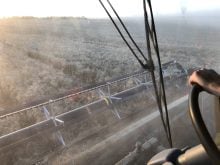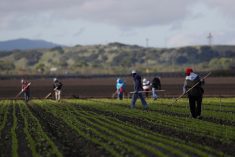A group of ag and food organizations will band together to develop a national strategy addressing labour shortages in the farm and food sectors.
“Labour challenges in agriculture have been ongoing for decades, and are one of the most prominent factors obstructing the remarkable growth potential that has been identified for Canadian agriculture and our agri-food industry as a whole,” said Mary Robinson, president of the Canadian Federation of Agriculture in an Oct. 13 news release.
A coalition including the CFA, the Canadian Agricultural Human Resource Council (CAHRC), Food and Beverage Canada, federal government initiative the Future Skills Centre, and others, will take two years to study the labour shortage “from all angles” and map out a plan to address it, CAHRC said in a news release.
Read Also

Manitoba boosts stake in cereals centre to $23.5 million
Premier Wab Kinew said the additional project funds will help ‘Trump-proof’ the provincial economy.
A shortage of workers has existed for decades, the CFA said, and its trajectory is “alarming.”
“Prior to COVID, Canadian farmers lost $1.5 billion in 2014 simply because they could not find people to work,” the organization said in the news release. “In 2020 COVID further exacerbated this chronic labour shortage, pushing Canadian farmers’ losses to $2.9 billion in revenue.”
“CFA has been calling to develop a national labour strategy for decades, and we are very pleased to be partnering on this project. An initiative such as this is sorely needed to not only help unlock the potential growth of Canada’s agriculture and agri-food sectors, but also to ensure the long-term health of our Canadian food supply chain,” Robinson added.
CAHRC chair Paul Glenn told the Co-operator that the last study done of the worker shortage was in 2013, and this didn’t include an action strategy.
The working group will cast “a very broad net,” he said. Besides farm production and food and beverage production, it will also look at how emerging ag technology and automation can impact the sector and attract workers who might not have otherwise worked in agriculture.
“Because really, it’s an exciting time to be in agriculture,” Glenn said, referring to the new technological tools developing in agriculture and the new types of jobs they bring.
The group will also look at compensation data, Glenn said.
“We need to really understand. Is it compensation that’s limiting people from coming to agriculture?” he said.
“Is it that they never thought about being that real economic driver for Canada as we come through COVID, or are they just regionally based?” he said, adding he’s seen a trend of people moving away from city centres, which may allow agriculture to capitalize on a new workforce.
Education will also be examined — for instance, how to promote agriculture in schools so kids know early on it’s a career option.
“Then we can start to build a workforce for agriculture early on,” he said.
















